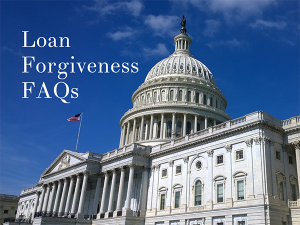Paycheck Protection Program – Loan Forgiveness FAQs
The CARES Act includes loan forgiveness provisions for loans received under the Paycheck Protection Program (PPP). The exact details are not yet clear. However, the Small Business Administration (SBA) has promised clarification of the forgiveness provisions at a future date. This Q&A is intended to help you understand the basics.
For more information and FAQs, visit the U.S. Department of Treasury website.
 How long do I have to spend the money?
How long do I have to spend the money?
Eight weeks. The clock starts when the PPP loan is funded. These eight weeks are referred to as the “covered period”.
Can I delay receipt of the money so that the clock will start later?
No. The intent of the program is to help businesses make payroll now, not later.
How do I record the loan proceeds?
Debit cash, credit a new liability account called “PPP Loan”.
Do I need a separate bank account to track PPP proceeds and their use?
There is no requirement to have a separate bank account. As a best practice, you might consider putting the proceeds in your business savings account and transfer funds into your checking and payroll accounts as you spend the funds on covered costs.
What do I have to spend the proceeds of the PPP loan on?
Payroll costs, rent, utilities, and interest. These are referred to as “covered costs”. At least 75% of the proceeds must be spent on payroll costs to maximize loan forgiveness.
What gets included for payroll cost?
The definition is exactly the same as it was for the computation of the loan amount. Payroll cost includes gross wages, cash tips, vacation, parental, family, medical or sick leave, allowance for separation or dismissal, group health insurance, retirement, and state and local taxes assessed on wages. Payroll cost does NOT include the employer’s portion of payroll taxes or workers’ compensation premiums.
What if I have already laid off my employees?
The intent of the program is for you to be able to keep paying all employees their regular pay, whether they are working or not. Consult with your employment law attorney as you consider the terms for rehiring any employees to restore your FTE count.
How is the $100,000 wage limit applied in the 8-week period?
Since you don’t yet know who will make over $100K, the limit is pro-rated to your pay period. Example: For a company that pays weekly, wages over $1,923 to any one person in one pay period wouldbe excluded (100,000/52). For a company that pays bi-weekly, wages over $3,846 to any one person in one pay period would be excluded (100,000/26). And so on… Practical tip…. If you are on anything other than a weekly pay period, consider switching to weekly so that you maximize the payroll costs incurred within the 8-week covered period.
What is rent, and does related party rent count?
The CARES Act does not specify rent for real or personal property, so we assume it means
both. However, you can only include rent paid under a leasing agreement in force (signed) before February 15, 2020. There is no reference to related parties in CARES, so we assume that rent paid to related parties is included. Capital leases are excluded because they are a financing agreement and not a leasing agreement.
What utilities are included?
Payment for a service for the distribution of electricity, gas, water, transportation, telephone, or internet access for which service began before February 15, 2020. A “transportation utility” has been interpreted to mean fuel costs for business vehicles.
What interest expense is included?
Interest on loans secured by real or personal property that were in effect before February 15, 2020. If your line of credit is secured by real or personal property, then the interest paid on the line would be included.
How much of the PPP loan can be forgiven?
Up to 100%.
How will my forgiveness be reduced?
There are three answers to this question, and each are addressed separately:
- If all the proceeds are not spent. If you do not have enough payroll, rent, utility, and interest costs during the 8-week period to spend all the proceeds.
- If your FTE count drops. FTE (full-time equivalent) is not defined, but we assume it has the same meaning it has always had. A person who works 40 hours per week is counted as 1.0, while a person who works 24 hours per week is counted as 0.6. FTEs are measured and averaged using each pay period during the 8-week period. The average number of FTEs is then compared to a The employer gets to choose the base period that is most beneficial (a) February 15, 2019 – June 30, 2019, or (b) January 1, 2020 – February 29, 2020.
Example: A business receives a $100,000 PPP loan.
– Average FTEs during the 8-week period was 21.
– Average FTEs between February 15 – June 30, 2019 was 35.
– Average FTEs between January 1 – February 29, 2020 was 30.
This business would choose the 2020 period as the base period because the average is lower. The calculation for maximum loan forgiveness would be: 21/30 * $100,000 =
$70,000. This means that $30,000 of the loan will have to be repaid.
- If employee salaries/wages are cut more than 25%. This step is very math-intensive because you must look at every employee (who made less than $100,000 in 2019) individually, especially if compensation is reduced across the board. The CARES Act includes an “apples to oranges” comparison by utilizing a base period of 12-weeks and comparing those wages to our 8-week period. We don’t believe that was their intent and have included examples based on our interpretation of what was intended. The same concept of wage reduction would apply to individuals who are on salary or paid hourly.
Example: Joe normally makes $1,000 per week for 40 hours, but you cut his salary to $650 per week. If Joe was receiving the reduced salary for all eight weeks, you would reduce the maximum loan forgiveness by $800 for Joe. $1,000 * 25% = $250 is the allowed reduction; Joe’s reduction is $1,000 – $650 = $350. Penalty is computed as: ($350 – $250) * 8 weeks = $800.
Example: Mary makes $20/hour, but you cut her rate to $13/hour. Mary normally works 30 hours per week. Assume Mary’s hours are constant all 8 weeks; you would reduce the maximum loan forgiveness by an additional $480 for Mary. $20 * 25% = $5 is the allowed reduction per hour. Mary’s reduction was $20 – $13 = $7. Penalty is computed as ($7 – $5) * 30 hours * 8 weeks = $480.
Can I avoid forgiveness reduction?
Yes, if you eliminate the reduction in FTEs and eliminate the reduction in wages by June 30, 2020. The exact details of what this means need to be clarified by the SBA.
What documentation will I have to provide to support my forgiveness calculation? Calculations for FTEs, payroll tax filings (Form 941 and payroll registers), verification of payment (canceled checks, bank statements), account statements, bills, etc. We recommend keeping a spreadsheet of all eligible expenses as they are incurred and filing copies of the supporting documentation in a special folder. A copy of the bank statement with eligible expenditures highlighted would also be helpful to support any EFT payments.
The SBA is clear on this point: no documentation = no forgiveness.
What if I pay my utilities with my business credit card?
Keep track of what you have charged to the credit card that is an eligible covered cost and make sure you apply a cash payment from the proceeds to the credit card bill before the end of the 8-week period.
Do I account for my covered costs during the 8-week period on a cash or accrual basis?
There is no guidance yet on whether the covered costs are to be included on a cash or accrual basis. We will distribute guidance on this question when it is received from the SBA. We believe the cash basis will be easier to support on your forgiveness application.
What if my payroll costs during the 8-week period use up 100% of my loan proceeds? Is this ok or do I have to spend some of the money on rent, utilities, and interest?
It is acceptable to spend 100% of the proceeds on payroll costs. The only SBA restriction is that at least 75% of the proceeds have to be spent on payroll costs.
What if I do not spend 100% of the loan proceeds on covered costs?
There is no clear guidance on what you are required to do with the excess. It was inferred by an SBA representative in a Townhall Meeting that you have two options: (a) repay the excess immediately and reduce the loan amount or (b) keep the excess and repay it within the two-year loan period.
What happens if I don’t follow the rules for use of proceeds?
The SBA can charge you with fraud in addition to making you repay the misused amounts.
Is the forgiven amount considered taxable income?
No.
How do I apply for forgiveness?
We are waiting on details for the process. Just like the application process, we anticipate that each lender will have their own process and requirements for applying for forgiveness.
When will I know if my forgiveness application has been approved?
The lender has 60 days to review and either approve or deny the application.
What are the terms of the loan (the portion that is not forgiven)?
1% and the term is two years. No collateral, no personal guarantee required, and no prepayment penalties.
How does the remaining loan get repaid?
No payments are due for six months; however, interest accrues during this deferral period. The actual loan amortization (how principal will be repaid) is not defined.
Disclosure: Please remember that past performance may not be indicative of future results. Different types of investments involve varying degrees of risk, and there can be no assurance that the future performance of any specific investment, investment strategy, or product (including the investments and/or investment strategies recommended or undertaken by Versant Capital Management, Inc.), or any non-investment related content, made reference to directly or indirectly in this article will be profitable, equal any corresponding indicated historical performance level(s), be suitable for your portfolio or individual situation, or prove successful. Due to various factors, including changing market conditions and/or applicable laws, the content may no longer be reflective of current opinions or positions. Moreover, you should not assume that any discussion or information contained in this article serves as the receipt of, or as a substitute for, personalized investment advice from Versant Capital Management, Inc. To the extent that a reader has any questions regarding the applicability of any specific issue discussed above to his/her individual situation, he/she is encouraged to consult with the professional advisor of his/her choosing. Versant Capital Management, Inc. is neither a law firm nor a certified public accounting firm and no portion of the article content should be construed as legal or accounting advice. If you are a Versant Capital Management, Inc. client, please remember to contact Versant Capital Management, Inc., in writing, if there are any changes in your personal/financial situation or investment objectives for the purpose of reviewing/evaluating/revising our previous recommendations and/or services. A copy of the Versant Capital Management, Inc.’s current written disclosure statement discussing our advisory services and fees is available upon request.
